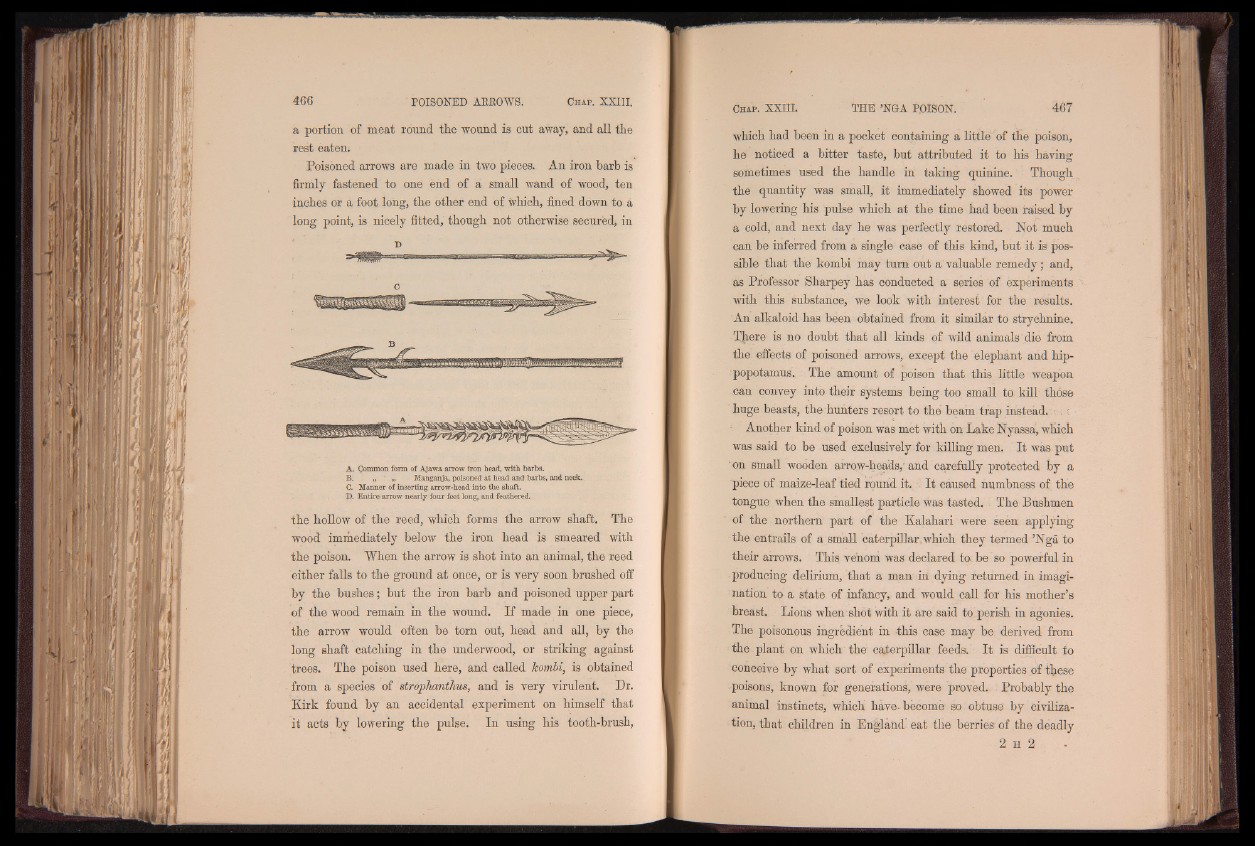
a portion of meat round the wound is cut away, and all the
rest eaten.
Poisoned arrows are made in two pieces. An iron barb is
firmly fastened to one end of a small wand of wood, ten
inches or a foot long, the other end of which, fined down to a
long point, is nicely fitted, though not otherwise secured, in
D
A. Common form of Ajawa arrow iron head, with barbs.
B. „ • „ Manganja, poisoned at head and barbs, and neek.
C. Manner of inserting arrow-head into the shaft. .
I). Entire arrow nearly four feet long, and feathered.
the hollow of the reed, which forms the arrow shaft. The
wood immediately below the iron head is smeared with
the poison. When the arrow is shot into an animal, the reed
either falls to the ground at once, or is very soon brushed off
by the bushes; but the iron barb and poisoned upper part
of the wood remain in the wound, i f made in one piece,
the arrow would often be torn out, head and all, by the
long shaft catching in the underwood, or striking against
trees. The poison used here, and called Tcombi, is obtained
from a species of strophanthus, and is very virulent. Dr.
Kirk found by an accidental experiment on himself that
it acts by lowering the pulse. In using his tooth-brush,
which had been in a pocket containing a little' of the poison,
he noticed a bitter taste, but attributed it to his having
sometimes used the handle in taking quinine. Though
the quantity was small, it immediately showed its power
by lowering his pulse which at the time had been raised by
a cold, and next day he was perfectly restored. Not much
can be inferred from a single case of this kind, but it is possible
that the kombi may turn out a valuable remedy; and,
as Professor Sharpey has conducted a series of experiments
with this substance, we look with interest for the results.
An alkaloid has been obtained from it similar to strychnine.
There is no doubt that all kinds of wild animals die from
the effects of poisoned arrows, except the elephant and hippopotamus.
The amount of poison that this little weapon
can convey into their systems being too small to kill those
huge beasts, the hunters resort to the beam trap instead. : . c
Another kind of poison was met with on Lake Nyassa, which
was said to be used exclusively for killing men. It was put
'on small wooden arrowheads,'and carefully protected by a
piece of maize-leaf tied round it. I t caused numbness of the
tongue when the smallest particle was tasted. The Bushmen
of the northern part of the Kalahari were seen applying
the entrails of a small caterpillar.which they termed ’Nga to
their arrows. This venom was declared to be so powerful in
producing delirium, that a man in dying returned in imagination
to a state of infancy, and would call for his mother’s
breast. Lions when: shot with it are said to perish in agonies.
The poisonous ingredient in this case may be, derived from
the plant on which the caterpillar feeds. I t is difficult to
conceive by what sort of experiments the properties of these
poisons, known for generations, were proved. Probably the
animal instincts, which have-become so obtuse by civilization,
that children in England eat the berries of the deadly
2 H 2